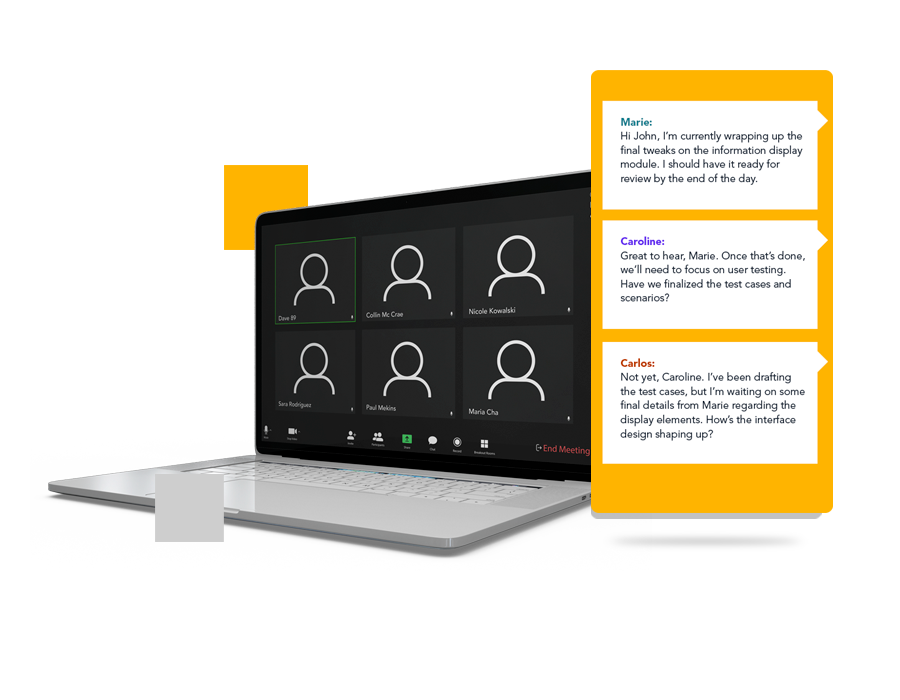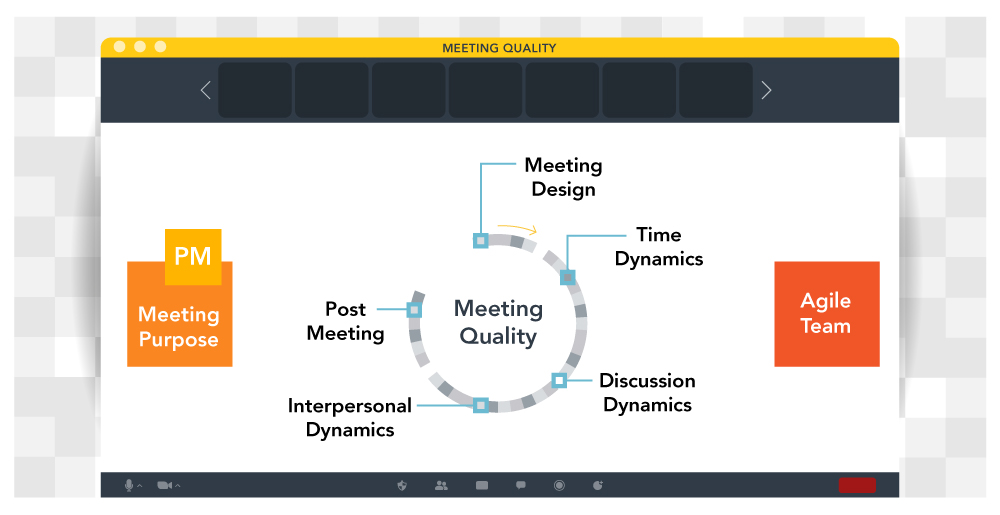Writing for
Good
Insights
In Brief
At Edify, we prioritize crafting high-quality meetings that are well-structured and purposeful. Our approach ensures that meetings are productive, inclusive, and respectful of everyone’s time and contributions.
Key elements of successful meetings include a clear purpose, advance sharing of agendas, having the right mix of attendees, and using efficient technology.
Why Do We Want High-Quality Meetings?
We are always working towards project success, designing meetings with respect for everyone’s time and contributions. This creates a culture of inclusivity, mutual respect, and highly productive teams. To ensure our meetings are top-notch, we include a few key elements. These elements are the magic potion that drives a meeting towards its purpose and ensures everyone benefits.

So, let’s explore these critical ingredients of successful meetings and chat about how we can measure them to continuously improve our meetings.

Meeting Design
Planning for Success:
Pulling together a valuable and enjoyable meeting starts with a well-thought-out plan. Let’s think of it like a roadmap – we need to clearly outline what (Meeting Purpose) we want to achieve in our get-together. Encouraging everyone to chip in with their ideas for the agenda means we won’t miss any critical points, making our meeting super productive!
To ensure we’re all on the same page, we should share the agenda in advance. This will give everyone a chance to organize their thoughts and come prepared, ready to contribute valuable ideas that align with our meeting’s purpose.
Having the right mix of people at the meeting is also vital. We need to invite those whose input is essential, as their insights will help us hit the targets we’ve set for our meeting.
Finally, let’s not forget about the technology we’re using. We need tools to make our discussion smooth and efficient without pesky tech hitches that could break our stride. A smooth tech experience will help us keep the conversation flowing freely, which is crucial for reaching our meeting’s purpose. Let’s do this and make our meeting a success!
| Meeting Design Checklist | Y/N |
| The meeting purpose or goals is clearly defined. | |
| Meeting attendees provided input for the agenda. | |
| The agreed agenda for the meeting was distributed ahead of the meeting. | |
| Necessary materials were provided in advance of the meeting. | |
| All the relevant people have been invited to the meeting. (nobody that was needed was missing) | |
| The right amount of people were invited to the meeting, (not too many people invited to the meeting). | |
| The people present at the meeting are only the ones needed as per the meeting’s purpose. (nobody that is not needed is present). | |
| Helpful technology in facilitating the discussion has been identified. (e.g. interactive whiteboard, polls, breakout rooms, etc). |
Mastering Time Management:
Time Dynamics
Managing our time well is key to making our meetings successful. When a meeting starts and ends on time, it shows that we value everyone’s time—it’s a way of saying, “We respect you.” Plus, being punctual is professional and courteous. Being on time means our meeting can go ahead as planned, and it helps to create a respectful and considerate environment.
To make the most of our meeting, let’s plan our time carefully. This means creating a detailed agenda, setting specific time slots for each topic, and ensuring everyone can have their say.
The pace of our meeting matters, too. We don’t want to rush, or we might not have time to thoroughly discuss our ideas or take in all the information. But we don’t want to slow down too much either, as we might lose focus or interest.
Most importantly, let’s ensure our meeting is needed and valuable for everyone. We don’t want to meet just for the sake of it. Our meetings should be a good use of time, a chance to have meaningful discussions, make decisions, and work together. Remember, a well-run meeting can be a great way to communicate and make progress – it’s not a waste of time; it’s time well spent!
Time Dynamics Checklist | Y/N |
All attendees are on time to the meeting. | |
Meeting started on time. | |
Attendees are prepared for the meeting. | |
The project facilitator or leader came prepared to the meeting. | |
The time allotted to the meeting was well planned. (instead of more time than is actually needed) | |
The time in the meeting was used effectively. | |
The meeting’s timing was pleasant. (not rushed, pushed, or too slow) | |
The meeting ends on time. | |
The meeting is actually necessary. |
Fostering Collaboration:
Interpersonal Dynamics
Interpersonal dynamics can make or break a meeting. They can turn a meeting into an amazingly collaborative session or, on the flip side, lead to an unproductive gathering. A fantastic meeting is all about appreciating and respecting the different perspectives everyone brings to the table. It’s a place brimming with active listening and understanding, creating a welcoming and inclusive vibe.
In these meetings, conversation flows freely, and everyone has their say. It’s not just a couple of people dominating the chat. This ensures that every voice is heard and valued. Disagreements? They’re just a normal part of any discussion and should be seen as a chance to dive deeper and understand the topic.
Keeping a positive attitude is vital. Stay open and receptive to new ideas, even if they challenge what you think you know. This openness to fresh ideas and change is the spark that drives the meeting forward and leads to those ‘aha!’ moments and decisions.
Interpersonal Dynamics Checklist | Y/N |
Multiple perspectives were taken into consideration. | |
Attendees made an effort to listen and understand one another on the matter at hand. | |
The conversation was open. (not dominated by few attendees at the expense of others) | |
Disagreements were kept on the positive and productive side of things. (not counterproductive and unnecessary) | |
People treated each other with respect. | |
Attendees were positive. (not using the meeting for complaining) | |
Attendees were open to new ideas or new thinking. |
Driving Productive Conversation:
Discussion Dynamics
The magic of a meeting often lies in the quality and depth of the discussion. It can really make a difference in how productive and successful our get-together turns out to be. It’s super important for everyone to feel at ease and ready to share their thoughts and ideas openly and honestly. We all bring something unique to the table, right?
Wouldn’t it be amazing if everyone felt encouraged to join the conversation? Let’s foster an environment that’s both inclusive and vibrant. It helps heaps when everyone is fully present and focused, so let’s keep the multitasking and distractions to a minimum.
Sticking to our agenda helps us keep the discussion on point, ensuring we cover all the critical issues and avoid those pesky, unproductive detours.
And guess what? We’re all about critical thinking and thoughtful decision-making. Everyone gets to have a say in the final decisions. This way, we’re making the best choices possible and fostering a sense of shared responsibility and ownership. Now, that’s what we call teamwork!
Discussion Dynamics Checklist | Y/N |
Attendees were able to speak frankly. (not holding back ideas or candid thoughts) | |
Participants were encouraged to participate. | |
Attendees were straightforward in their point. (instead of rambling on and not moving the conversation forward) | |
The meeting stayed only on the relevant topics. (instead of deviating into irrelevant topics) | |
Attendees were focused during the meeting. (i.e. not multitasking, chatting with others, or using cellphone) | |
Attendees were engaged. | |
Critical and thoughtful decision-making took place. |
Efficient Follow-Through:
Post-Meeting
A meeting’s effectiveness is determined not only by what happens during the meeting but also by what happens afterward. It’s really important that everyone leaves the meeting with clear action items that they’ve all agreed upon, knowing exactly what they need to do next.
Also, let’s not forget to include a thorough summary of the meeting, including the main points, the decisions made, and the problems solved. This way, everyone will have a reference point, and we can make sure we’re all on the same page moving forward.
The person leading the meeting plays a key role here. They should keep a close eye on all tasks and monitor the progress of each action item to ensure everything is on track. But remember, it’s also up to each person attending the meeting to work conscientiously on their tasks.
Lastly, if everyone regularly gives feedback about the quality of the meetings, it can help us understand how effective our meetings are and where we can improve them. This ongoing evaluation and reflection can enable us to continually improve our meetings, making them more productive and effective in the future.
Post-Meeting Checklist | Y/N |
Action items were clear and who is responsible when the meeting ends. | |
There was an effort to summarize what was resolved and decided on for the meeting by the end of the meeting. | |
The leader followed up on what everyone is supposed to do after a meeting. | |
Attendees actually worked on their action items after the meeting. | |
The meeting quality was assessed by attendees. |
Summarizing
Checklists are important reminders of key components of great meetings. Let’s not forget that not all of the checklist items are relevant to all meetings. However, they can keep us true to our purpose of making meetings a space where we focus on productivity, transforming them into valuable brainstorming sessions.
They foster open communication, tapping into our team’s collective wisdom and promoting innovation. Setting clear objectives and respecting timelines makes each meeting a productive step toward our goals.
These sessions also cultivate a respectful environment where every voice is heard, fostering insightful discussions and better decision-making. Post-meeting follow-ups ensure productivity extends beyond the meeting room, with clearly defined tasks and responsibilities.
Regularly reviewing the quality of our meetings allows for continuous improvement, making them more engaging and enjoyable. By focusing on these elements, meetings can enrich our work and projects, fostering a more efficient, collaborative, and successful work environment.
Useful Material
- Meeting Quality Index survey templates can be used with your team or to evaluate a sample of people company-wide.
- Quick Meeting Quality Index survey template to use after each meeting.